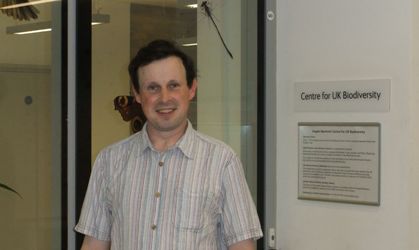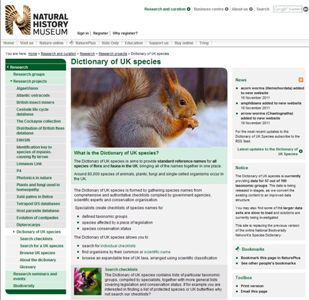The Species Dictionary is now under new management as Charles Hussey retired from the Natural History Museum at the end of June. Charles was in charge of the Dictionary since 2000 (except for a 1-year period when DEFRA funded a short-term post). Management of the Dictionary has now passed into the capable hands of Chris Raper. Dipterists will know Chris as the person who has been running (and will continue to run) the Tachinid Recording Scheme together with Matt Smith. But Chris also has 27 years of commercial experience developing databases and data-driven websites. This combination of interests and skills make Chris an ideal successor to take the Dictionary forwards.

The Dictionary actually predates the formation of the NBN, having grown out of the names list in the early versions of Recorder. As Charles explains: “It is now a product (the database), a service and a network. We are, in essence, data collators supported by over 100 people acting as list providers and editors”. The fact that the Dictionary is geared towards the needs of biological recorders makes it unique amongst species inventories. It aims to provide an authoritative naming service comprising a collection of over 230 checklists providing current names, and synonyms in use. Since 2000, when the Dictionary was transferred from the JNCC to the Natural History Museum, the number of checklists has grown from 182. Scientific names have grown from 86,000 to 243,000 and vernacular names from 8,500 to 36,000.
One of the first tasks when the Dictionary arrived at the Museum was to make a website. This became operational in October 2000 (although if was not formally launched until April 2003). Other developments included building a ‘toolkit’ to help with importing lists and managing the content, and adding new features. These included informal group names that make it easy to see what kind of animal, plant or fungus a species is, and a ‘name server’ which maps every name in the Dictionary to a recommended scientific name (this provides a vital function within the NBN Gateway as it ensures that all relevant records, including synonyms, are returned during a search). One of the latest improvements is an ‘organism’ table which provides a virtual master list and management classification. The website has recently been completely overhauled to take advantage of the new features in the Dictionary and to make it more attractive and easier to use. The new website was previewed at the NBN Conference last November with limited content but is now fully populated.
Users may not be aware of the amount of work that goes on behind the scenes to improve data quality and keep the name-mapping up to date: over the 9-year period from April 2003 to April 2012 more than 593,000 changes have been made – that equates to 300 per working day!

The Species Dictionary is now firmly established as an important part of the NBN family of services. It provides the taxonomy within Recorder and the NBN Gateway and also serves other NBN partners, amateurs and the general public, as well as the international biodiversity informatics community.
Any enquiries concerning the Dictionary can be sent to speciesdictionary@nhm.ac.uk or by posting to the Species Dictionary Forum. The Dictionary website is found here.
Written by Charles Hussey
Comment from Jim Munford
The National Biodiversity Network is truly a collective of people quietly going about their business, each one serving their own purpose, not seeking public acknowledgement or praise, but whose collective and several endeavours have created something of national, indeed international, significance and importance. One of those largely unsung heroes is Charles Hussey of the Natural History Museum who is now entering retirement. Charles’ efforts to build and maintain the species dictionary have been fundamental to the NBN. I am sure Charles himself would also wish to acknowledge the work of his companion at arms, John Tweddle, now Head of the Angela Marmont Centre for UK Biodiversity. I used to occasionally visit the pair of them, secure in their Natural History Museum tower, and wonder at the sheer effort required to maintain the dictionary without which the NBN, as we presently know it, could not function. I hope Charles will be able to maintain a link to the NBN – we might even get his rotifer data! I for one will miss his dry humour and esoteric Power Point presentations featuring cartoons from ancient punch magazines and other eclectic sources.
